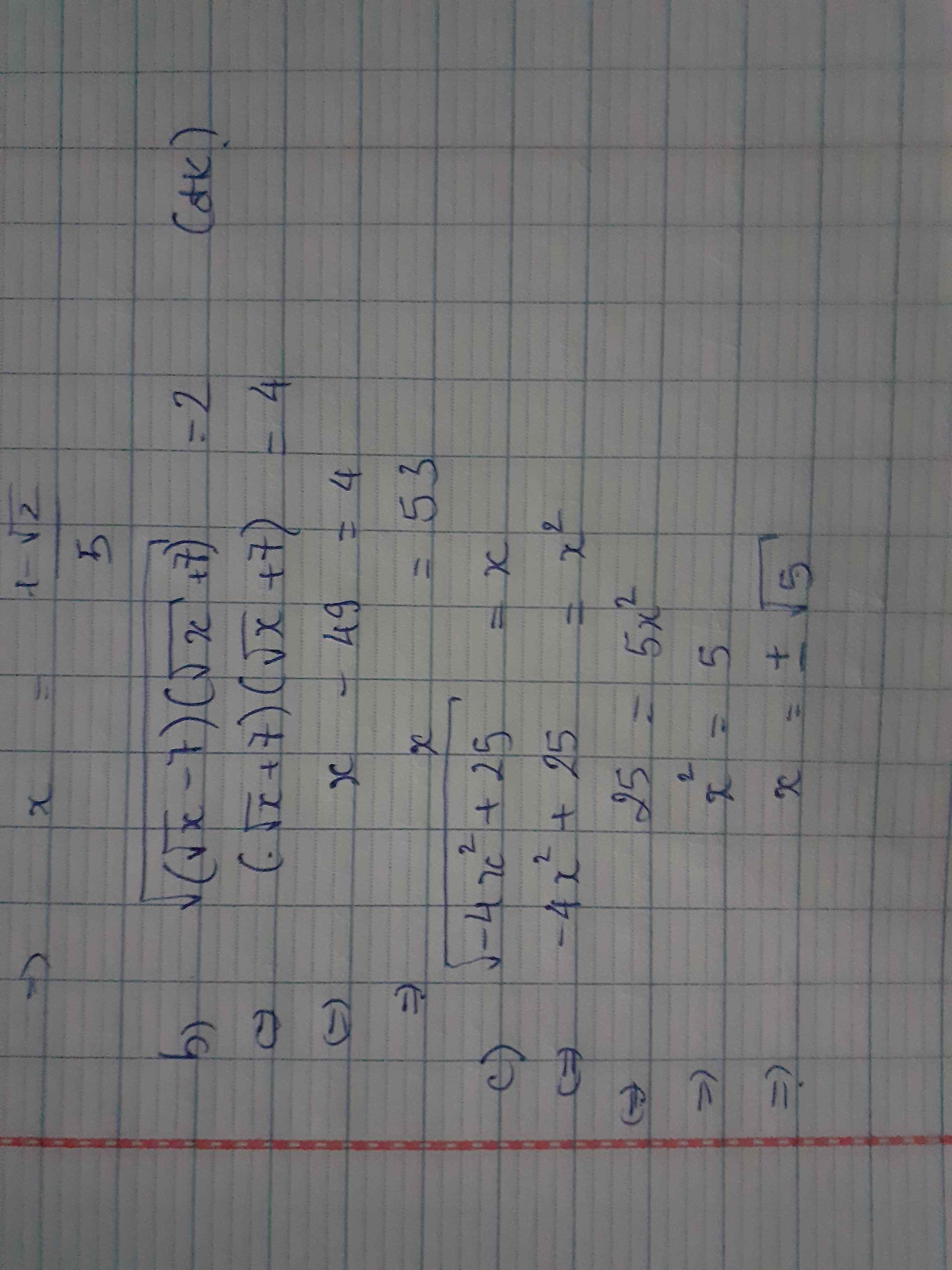\(\sqrt[3]{4x+1}=\sqrt[3]{-7}\)

Những câu hỏi liên quan
a) \(\sqrt{4x^2-9}=2\sqrt{x+3}\)
b) \(\sqrt{4x+20}+3\sqrt{\dfrac{x-5}{9}}-\dfrac{1}{3}\sqrt{9x-45}=4\)
c) \(\dfrac{2}{3}\sqrt{9x-9}-\dfrac{1}{4}\sqrt{16x-16}+27\sqrt{\dfrac{x-1}{81}}=4\)
d)\(5\sqrt{\dfrac{9x-27}{25}}-7\sqrt{\dfrac{4x-12}{9}}-7\sqrt{x^2-9}+18\sqrt{\dfrac{9x^2-81}{81}}=0\)
\(a) \sqrt{4x^2− 9} = 2\sqrt{x + 3}\)
\(ĐK:x\ge\dfrac{3}{2}\)
\(pt\Leftrightarrow4x^2-9=4\left(x+3\right)\)
\(\Leftrightarrow4x^2-9=4x+12\)
\(\Leftrightarrow4x^2-4x-21=0\Leftrightarrow\left[{}\begin{matrix}x=\dfrac{1-\sqrt{22}}{2}\left(l\right)\\x=\dfrac{1+\sqrt{22}}{2}\left(tm\right)\end{matrix}\right.\)
\(b)\sqrt{4x-20}+3.\sqrt{\dfrac{x-5}{9}}-\dfrac{1}{3}\sqrt{9x-45}=4\)
\(ĐK:x\ge5\)
\(pt\Leftrightarrow2\sqrt{x-5}+\sqrt{x-5}-\sqrt{x-5}=4\)
\(\Leftrightarrow2\sqrt{x-5}=4\Leftrightarrow\sqrt{x-5}=2\)
\(\Leftrightarrow x-5=4\Leftrightarrow x=9\left(tm\right)\)
Đúng 1
Bình luận (0)
\(c)\dfrac{2}{3}\sqrt{9x-9}-\dfrac{1}{4}\sqrt{16x-16}+27.\sqrt{\dfrac{x-1}{81}}=4\)
ĐK:x>=1
\(pt\Leftrightarrow2\sqrt{x-1}-\sqrt{x-1}+3\sqrt{x-1}=4\)
\(\Leftrightarrow4\sqrt{x-1}=4\Leftrightarrow\sqrt{x-1}=1\)
\(\Leftrightarrow x-1=1\Leftrightarrow x=2\left(tm\right)\)
\(d)5\sqrt{\dfrac{9x-27}{25}}-7\sqrt{\dfrac{4x-12}{9}}-7\sqrt{x^2-9}+18\sqrt{\dfrac{9x^2-81}{81}}=0\)
\(ĐK:x\ge3\)
\(pt\Leftrightarrow3\sqrt{x-3}-\dfrac{14}{3}\sqrt{x-3}-7\sqrt{x^2-9}+6\sqrt{x^2-9}=0\)
\(\Leftrightarrow-\dfrac{5}{3}\sqrt{x-3}-\sqrt{x^2-9}=0\Leftrightarrow\dfrac{5}{3}\sqrt{x-3}+\sqrt{x^2-9}=0\)
\(\Leftrightarrow(\dfrac{5}{3}+\sqrt{x+3})\sqrt{x-3}=0\)
\(\Leftrightarrow\sqrt{x-3}=0\) (vì \(\dfrac{5}{3}+\sqrt{x+3}>0\))
\(\Leftrightarrow x-3=0\Leftrightarrow x=3\left(nhận\right)\)
Đúng 0
Bình luận (0)
1)7sqrt{3x-7}+left(4x-7right)sqrt{7-x}322)4x^2-11x+6left(x-1right)sqrt{2x^2-6x+6}3)9+3sqrt{xleft(3-2xright)}7sqrt{x}+5sqrt{3-2x}4)sqrt{2x^2+4x+7}x^4+4x^3+3x^2-2x-75)frac{6-2x}{sqrt{5-x}}+frac{6+2x}{sqrt{5+x}}frac{8}{3}6)2left(5x-3right)sqrt{x+1}+left(x+1right)sqrt{3-x}3left(5x+1right)7)sqrt{7x+7}+sqrt{7x-6}+2sqrt{49x^2+7x-42}181-14x
Đọc tiếp
1)\(7\sqrt{3x-7}+\left(4x-7\right)\sqrt{7-x}=32\)
2)\(4x^2-11x+6=\left(x-1\right)\sqrt{2x^2-6x+6}\)
3)\(9+3\sqrt{x\left(3-2x\right)}=7\sqrt{x}+5\sqrt{3-2x}\)
4)\(\sqrt{2x^2+4x+7}=x^4+4x^3+3x^2-2x-7\)
5)\(\frac{6-2x}{\sqrt{5-x}}+\frac{6+2x}{\sqrt{5+x}}=\frac{8}{3}\)
6)\(2\left(5x-3\right)\sqrt{x+1}+\left(x+1\right)\sqrt{3-x}=3\left(5x+1\right)\)
7)\(\sqrt{7x+7}+\sqrt{7x-6}+2\sqrt{49x^2+7x-42}=181-14x\)
Giải phương trình:
1, \(x^2+2x\sqrt{x-\dfrac{1}{x}}=3x+1\)
2, \(\left(13-4x\right)\sqrt{2x-3}+\left(4x-3\right)\sqrt{5-2x}=2+8\sqrt{16x-4x^2-15}\)
3, \(7\sqrt{3x-7}+\left(4x-7\right)\sqrt{7-x}=32\)
Bài 1: Tìm x
a/\(\sqrt{1-4x+4x^2}\)+5=x-2
b/\(3\sqrt{12+4x}\)+\(\dfrac{4}{7}\sqrt{147+49x}\)=\(\dfrac{3}{2}\sqrt{48+16x}\)+4
`a)sqrt{1-4x+4x^2}+5=x-2`
`<=>\sqrt{(2x-1)^2}=x-2-5`
`<=>|2x-1|=x-7(x>=7)`
`<=>[(2x-1=x-7),(2x-1=7-x):}`
`<=>[(x=-6(ktm)),(3x=8):}`
`<=>x=8/3(ktm)`
Vậy PTVN
`b)3sqrt{12+4x}+4/7sqrt{147+49x}=3/2sqrt{48+16x}+4(x>=-3)`
`<=>6sqrt{x+3}+4sqrt{x+3}=6sqrt{x+3}+4`
`<=>4sqrt{x+3}=4`
`<=>sqrt{x+3}=1<=>x+3=1`
`<=>x=-2(tm)`
Vậy `S={-2}`
Đúng 1
Bình luận (0)
a) \(\sqrt{1-4x+4x^2}+5=x-2\Leftrightarrow\sqrt{\left(1-2x\right)^2}+5=x-2\Leftrightarrow\left|1-2x\right|=x-7\left(1\right)\)TH1: \(1-2x\ge0\Leftrightarrow x\le\dfrac{1}{2}\)
\(\left(1\right)\Leftrightarrow1-2x=x-7\Leftrightarrow3x=8\Leftrightarrow x=\dfrac{8}{3}\)(không thỏa đk)
TH2: \(1-2x< 0\Leftrightarrow x>\dfrac{1}{2}\)
\(\left(1\right)\Leftrightarrow2x-1=x-7\Leftrightarrow x=-6\)(không thỏa đk)
Vậy \(S=\varnothing\)
b) \(3\sqrt{12+4x}+\dfrac{4}{7}\sqrt{147+49x}=\dfrac{3}{2}\sqrt{48+16x}+4\Leftrightarrow6\sqrt{3+x}+4\sqrt{3+x}=6\sqrt{3+x}+4\Leftrightarrow4\sqrt{3+x}=4\Leftrightarrow\sqrt{3+x}=1\Leftrightarrow3+x=1\Leftrightarrow x=-2\)
Đúng 0
Bình luận (1)
a. \(\sqrt{1-4x+4x^2}+5=x-2\)
\(\Leftrightarrow\sqrt{\left(1-2x\right)^2}+5=x-2\)
\(\Leftrightarrow\left|1-2x\right|-x=-7\)
\(\Leftrightarrow\left[{}\begin{matrix}1-2x-x=-7\\2x-1-x=-7\end{matrix}\right.\) \(\Leftrightarrow\left[{}\begin{matrix}-3x=-8\\x=-6\end{matrix}\right.\) \(\Leftrightarrow\left[{}\begin{matrix}x=\dfrac{8}{3}\\x=-6\end{matrix}\right.\)
b. ĐKXĐ: \(x\ge-3\)
\(3\sqrt{12+4x}+\dfrac{4}{7}\sqrt{147+49x}=\dfrac{3}{2}\sqrt{48+16x}+4\)
\(\Leftrightarrow6\sqrt{3+x}+4\sqrt{3+x}-6\sqrt{3+x}=4\)
\(\Leftrightarrow4\sqrt{3+x}=4\) \(\Leftrightarrow\sqrt{3+x}=1\Leftrightarrow3+x=1\Leftrightarrow x=-2\) ( thỏa mãn đk )
Đúng 0
Bình luận (0)
Xem thêm câu trả lời
2.tìm x
a)\(\sqrt{x^2-6x+9}\)
b)\(\sqrt{x^2-2x+1}\)
c)\(\sqrt{4x+12}-3\sqrt{x+3}+7\sqrt{9x+27}=20\)
d)\(\sqrt{4x+20}+3\sqrt{\dfrac{x-5}{9}}-\dfrac{1}{3}\sqrt{9x-45}=6\)
a) \(\sqrt{x^2-6x+9}\)
\(=\sqrt{\left(x^2-2.x.3+3^2\right)}\)
\(=\sqrt{\left(x-3\right)^2}\) ≥0,∀x
⇒x∈\(R\)
b) \(\sqrt{x^2-2x+1}\)
\(=\sqrt{\left(x^2-2.x.1+1^2\right)}\)
\(=\sqrt{\left(x-1\right)^2}\) ≥0,∀x
⇒x∈\(R\)
Đúng 0
Bình luận (0)
Giải phương trình :
a) \(\sqrt{x^2}+\sqrt{x^2-2x+1}=1\)
b)\(\sqrt{4x^2-4x+1}=\sqrt{7-4\sqrt{3}}+\sqrt{7+4\sqrt{3}}\)
a: =>|x|+|x-1|=1
Trường hợp 1: x<0
Pt sẽ là -x+1-x=1
=>x=0(loại)
Trường hợp 2: 0<=x<1
Pt sẽ là x+1-x=1
=>1=1(luôn đúng)
Trường hợp 3: x>=1
Pt sẽ là x+x-1=1
=>2x=2
hay x=1(nhận)
b: \(\Leftrightarrow\left|2x-1\right|=2-\sqrt{3}+2+\sqrt{3}=4\)
=>2x-1=4 hoặc 2x-1=-4
=>2x=5 hoặc 2x=-3
=>x=5/2 hoặc x=-3/2
Đúng 0
Bình luận (0)
\(\sqrt{4x^2-4x+1}+2=3x\)
Rút gọn
\(7\sqrt{a}-5b\sqrt{16a^3}+4a\sqrt{25ab^2}-3\sqrt{16a}\) với a>0, b>0
\(\sqrt{4x^2-4x+1}+2=3x\)
Vì \(VT\ge2\Rightarrow VP\ge2\Rightarrow x\ge\dfrac{2}{3}\)
\(\Rightarrow\sqrt{\left(2x-1\right)^2}+2=3x\Rightarrow\left|2x-1\right|+2=3x\)
\(\Rightarrow2x-1+2=3x\left(x\ge\dfrac{2}{3}\right)\Rightarrow x=1\)
\(7\sqrt{a}-5b\sqrt{16a^3}+4a\sqrt{25ab^2}-3\sqrt{16a}\)
\(=7\sqrt{a}-20ab\sqrt{a}+20ab\sqrt{a}-12\sqrt{a}=-5\sqrt{a}\)
Đúng 1
Bình luận (0)
Giải pt
\(1)4x^2+\sqrt{3x+1}+5=13x\)
\(2)7x^2-13x+8=2x^2.\sqrt[3]{x\left(1+3x-3x^2\right)}\)
\(3)x^3-4x^2-5x+6=\sqrt[3]{7x^2+9x-4}\)
\(4)x^3-5x^2+4x-5=\left(1-2x\right)\sqrt[3]{6x^2-2x+7}\)
\(5)8x^2-13x+7=\left(1+\dfrac{1}{x}\right)\sqrt[3]{3x^2-2}\)
Để giải các phương trình này, chúng ta sẽ làm từng bước như sau: 1. 13x(7-x) = 26: Mở ngoặc và rút gọn: 91x - 13x^2 = 26 Chuyển về dạng bậc hai: 13x^2 - 91x + 26 = 0 Giải phương trình bậc hai này để tìm giá trị của x. 2. (4x-18)/3 = 2: Nhân cả hai vế của phương trình với 3 để loại bỏ mẫu số: 4x - 18 = 6 Cộng thêm 18 vào cả hai vế: 4x = 24 Chia cả hai vế cho 4: x = 6 3. 2xx + 98x2022 = 98x2023: Rút gọn các thành phần: 2x^2 + 98x^2022 = 98x^2023 Chia cả hai vế cho 2x^2022: x + 49 = 49x Chuyển các thành phần chứa x về cùng một vế: 49x - x = 49 Rút gọn: 48x = 49 Chia cả hai vế cho 48: x = 49/48 4. (x+1) + (x+3) + (x+5) + ... + (x+101): Đây là một dãy số hình học có công sai d = 2 (do mỗi số tiếp theo cách nhau 2 đơn vị). Số phần tử trong dãy là n = 101/2 + 1 = 51. Áp dụng công thức tổng của dãy số hình học: S = (n/2)(a + l), trong đó a là số đầu tiên, l là số cuối cùng. S = (51/2)(x + (x + 2(51-1))) = (51/2)(x + (x + 100)) = (51/2)(2x + 100) = 51(x + 50) Vậy, kết quả của các phương trình là: 1. x = giá trị tìm được từ phương trình bậc hai. 2. x = 6 3. x = 49/48 4. S = 51(x + 50)
Đúng 0
Bình luận (0)
Giải phương trình sau:
1, \(\sqrt{5x+3}\) = \(\sqrt{3-\sqrt{2}}\)
2, \(\sqrt{\left(\sqrt{x}-7\right)\left(\sqrt{x}+7\right)}\) = 2
3,\(\sqrt{-4x^2+25}=x\)
1. ĐKXĐ: $x\geq \frac{-3}{5}$
PT $\Leftrightarrow 5x+3=3-\sqrt{2}$
$\Leftrightarrow x=\frac{-\sqrt{2}}{5}$
Đúng 1
Bình luận (0)
2. ĐKXĐ: $x\geq \sqrt{7}$
PT $\Leftrightarrow (\sqrt{x}-7)(\sqrt{x}+7)=4$
$\Leftrightarrow x-49=4$
$\Leftrightarrow x=53$ (thỏa mãn)
Đúng 2
Bình luận (0)
Xem thêm câu trả lời
Giải phương trình
\(a.\dfrac{3}{4}\sqrt{4x}-\sqrt{4x}+5=\dfrac{1}{4}\sqrt{4x}\)
\(b.\sqrt{3-x}-\sqrt{27-9x}+1,25.\sqrt{48-16x}=6\)
\(c.\dfrac{5\sqrt{x}-2}{8\sqrt{x}+2,5}=\dfrac{2}{7}\)
\(d.\sqrt{9x^2+12x+4}=4\)
d. \(\sqrt{9x^2+12x+4}=4\)
<=> \(\sqrt{\left(3x+2\right)^2}=4\)
<=> \(|3x+2|=4\)
<=> \(\left[{}\begin{matrix}3x+2=4\\3x+2=-4\end{matrix}\right.\Leftrightarrow\left[{}\begin{matrix}3x=2\\3x=-6\end{matrix}\right.\Leftrightarrow\left[{}\begin{matrix}x=\dfrac{2}{3}\\x=-2\end{matrix}\right.\)
Đúng 0
Bình luận (0)
c: Ta có: \(\dfrac{5\sqrt{x}-2}{8\sqrt{x}+2.5}=\dfrac{2}{7}\)
\(\Leftrightarrow35\sqrt{x}-14=16\sqrt{x}+5\)
\(\Leftrightarrow x=1\)
Đúng 0
Bình luận (0)




























